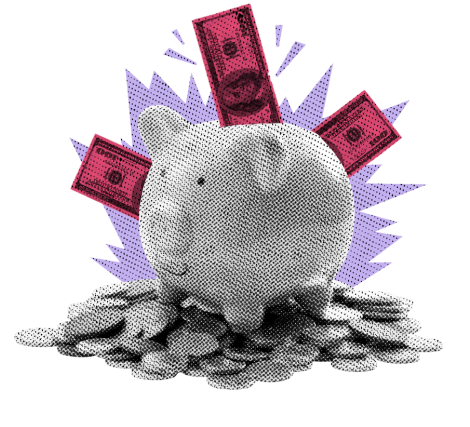
Wall Street wants clarity. Powell delivered ambiguity. Here's what you should really be watching.
KEY TAKEAWAYS
- Spring arrived on the calendar—but confusion still reigns on Wall Street.
- Powell’s Fed downgraded GDP and bumped up inflation projections.
- Consumer confidence is declining, and inflation expectations are rising.
- Powell dismissed sentiment indicators as “soft numbers,” but it's critical for forecasting consumption.
- Tariffs may cause a one-time inflation bump, but prices stay elevated permanently. 🤯
MY HOT TAKES
- The Fed’s messaging is intentionally vague to avoid spooking markets.
- GDP decline is inevitable if consumer and government spending slow.
- Inflation expectations are not anchored, regardless of what Powell says.
- Consumer confidence matters more than Powell gives it credit for.
- Tariffs may be “transitory” in inflation math, but not in real-life price pain.
- You can quote me: “It’s just math, stupid.”
Sprung. Guess who snuck in while we are trying to figure out what was happening in the markets. That’s right, yesterday marked the Vernal Equinox in the northern hemisphere, aka spring. On Wall Street, non-New Yorkers might not have guessed it due to the dreary, coldish climate that persisted. No Cherry Blossoms or crazy rituals, just misty, uncomfortable, cloudy, windy conditions. The kind of conditions that leave you guessing what coat to wear, if at all. That, my friends, is springtime on Wall Street. If you walked into the hallowed halls of our iconic New York Stock exchange, you would have found similar confusion; not about what coat to wear, but rather what to do with these markets.
Just a day earlier, master spinner and Fed Head Jerome Powell tried his best to explain what was going on, and really, he said a whole lot of… well, nothing, which I suppose is, kind of, his job. Let me clarify by saying that I believe that he, his committee of banker-economists, and the army of junior banker-economists that support them, are in the best position to render an opinion on all things money. Unfortunately, the Fed Chairman can’t just say what he thinks.
Earlier in the week, I opined on what I thought would come out of the meeting and, almost more importantly, the Summary of Economic Projections. I was sure that it would show a decline in GDP Growth and a bump in inflation expectations. This would be a worst-case scenario; just how much was the big question. On rate expectations, I was almost sure that the committee would leave their December guess unchanged (2 rate cuts before the end of the year). Moving that would show the Fed’s hand. If members upped it, investors might have gotten worried that they were anticipating trouble. If the FOMC lowered it, it would have implied that the Fed was worried about inflation. Both scenarios would have upset the extremely delicate balance which has the equity markets in a state of suspended animation. I also expected that the distribution of opinions would tighten up.
This is what we got. I was right on GDP and inflation, however there were some nuances worth reviewing. GDP growth was trimmed back more than I would have expected. It is quite clear that, while the economy is healthy today, that there is some trouble brewing. The numbers are hinting at it. AND besides, healthy or not, if you cut government spending, you cut GDP. Sorry, Mr. Commerce Secretary, it’s just math, stupid, and you know it, because you’re a bond guy. On that alone, we can expect a decline in GDP growth, if DOGE is successful in reducing the deficit. We have also discussed the recent slowing trend in personal expenditures. Those two alone make up 85% of GDP. I am not projecting or guessing. Consumers are spending less, and the Government is spending less.
If we want to project which way GDP growth will go in the near future, we can look at the most forward-looking indicators available. Let’s start with consumption, ⅔ of GDP. My regular readers know that I am obsessed with consumer confidence. To quote myself, “confident consumers consume.” Now, not everyone shares my love of sentiment indicators. In his press conference the other day, Chairman Powell was pressed by the press to comment on the recent decline in consumer confidence. He referred to those as “soft” numbers and claimed that the Fed was more concerned with the “hard” numbers like the ones mentioned in the last paragraph. 🙃☝️ I get it, but consumer confidence should not be ignored. There is also criticism that consumer confidence is politically biased. Consumer confidence numbers are based on surveys, and one would expect a dichotomy to exist in today’s politically charged environment. And it is. The University of Michigan Sentiment series publishes polling sentiment by political party and it is clear that Dems have lost significant confidence since… um, November of last year, while GOP respondents gained confidence. But if you look at the following chart, you will notice the Republican sentiment languished after an initial bump and actually tailed down in the last reading. Check it out and keep reading.

One final note on the political bias. Regardless of the bias, if you just assume that 50% of voters are happy and the other 50% sulky, even if only some of the sulkies cut back on expenses, there will be a noticeable change in consumption. It’s just math, stupid.
On that note, let’s move onto leading inflation indicators. The same University of Michigan Sentiment indicator can be useful here as well. Respondents are asked about inflation expectations in 1 year and the next 5 to 10 years, and the latest preliminary results show that folks expect near-term inflation to be at 4.9% and long-term at 3.9%. Wow, that is a long way from the 2% target set by the Fed. Worse yet, if I showed you a time-series chart of those numbers, you would see how they have recently spiked. This can be a real problem for the Fed. The problem lies in something called anchored inflation. If consumers expect inflation to be higher, they will cut back on spending, and vice versa. The problem is, not only are they not anchored–they are moving… higher. Now there is another problem with increasing inflation expectations; consumers will seek higher wages causing companies to spend more on labor, which ultimately leads to more inflation. This is referred to as a built-in inflation spiral–it’s not good.
Getting back to the Fed’s projections. Most people don’t focus on the Fed’s longer-term projections, because… well, those are hard to make and the Fed is notoriously wrong. However, in this last report, allowing one's gaze to include the longer-term inflation projections may have yielded an interesting find. As aforementioned, the Fed bumped up its 2025 inflation figure BUT not ‘26 and beyond. That could mean that FOMC members are expecting that one-time bump caused by tariffs, also known as “transitory” inflation, which became a bad word in 2021. Yes, it’s true, many tariff supporters are quick to remind us that tariffs will only cause prices to rise initially. BY AS MUCH AS 25%! 🤣 Because inflation is a rate of change, it will not increase the month after and will ultimately dissipate after a year because of the base effect. It’s just math, stupid. HOWEVER, consumers are not really upset about the inflation number itself, but rather the ACTUAL prices, which will be higher AND STAY HIGHER.
Now, we learned all this from the Fed’s published economic projections, which are all logical, based on recent economic numbers and the best available leading indicators. What was the Fed’s take on all this? Despite the GDP downgrade, Powell said that the economy was “strong overall.” This despite the committee’s clear downward reduction. Powell also said that inflation expectations were “anchored,” despite the numbers I shared above. Powell also acknowledged that consumers were uncomfortable with higher prices themselves, and not necessarily “transitory” inflation. Powell also acknowledged that the recent uptick in inflation was probably caused by tariffs. He referred to the recent uptick in goods inflation that I have pointed out to you recently. He was a bit roughed-up by the press and almost forced to admit that things are not exactly positive, though he managed to remain as positive as possible–he is a real pro. He also acknowledged the growing uncertainty around tariffs, economic growth, unemployment related to DOGE activities, and inflation.
President Harry Truman was quoted saying, "Give me a one-handed economist! All my economists say, ‘On the one hand… on the other hand…’" Folks, Powell did a good job on Wednesday. He not only avoided a market panic, but the markets rallied after his press conference. However, he was far from a one-handed economist. In my opinion, we really learned nothing new. That leaves us wondering if we should be wearing a heavy or a light coat, or any coat at all. On Powell’s implying that consumer confidence is a “soft” number, I will let you decide how much import to impute on those figures. You know where I stand on them. I am confident that my long-term, informed view will pay off.
YESTERDAY’S MARKETS
Markets closed slightly lower yesterday despite early-session gains. Existing Home Sales surprised traders on the upside which initially goosed equities, but the bulls ultimately capitulated to the realities of looming tariffs and the Fed’s day earlier ambiguity. After yesterday’s close, NIKE hit a foul ball with a weaker than expected outlook cushioned by excuses; the retail brand giant’s miss will weigh heavy on this morning’s open.

NEXT UP
- No releases today, but next will be chock-full with releases. We will get PMIs (leading indicator of that third aggregate of GDP growth), more housing numbers, Consumer Confidence, Durable Goods Orders, GDP, Personal Spending, Personal Income, PCE Price Index, and University of Michigan Sentiment.
- Today is Triple Witching, which involves index options, index futures, and individual stock options expiration. This typically adds to increased volume and volatility.
- Fed speakers today: Goolsbee and Williams.
.png)

